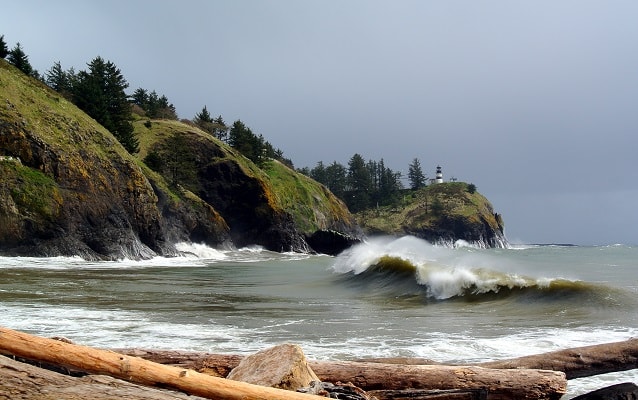Last updated: December 30, 2021
Place
Cape Disappointment

Photo by Adbar
Gifts/Souvenirs/Books, Historical/Interpretive Information/Exhibits, Parking - Auto, Restroom, Scenic View/Photo Spot, Trailhead, Trash/Litter Receptacles
Lewis and Clark NHT Visitor Centers and Museums
This map shows a range of features associated with the Lewis and Clark National Historic Trail, which commemorates the 1803-1806 Lewis and Clark Expedition. The trail spans a large portion of the North American continent, from the Ohio River in Pittsburgh, Pennsylvania, to the mouth of the Columbia River in Oregon and Washington. The trail is comprised of the historic route of the Lewis and Clark Expedition, an auto tour route, high potential historic sites (shown in black), visitor centers (shown in orange), and pivotal places (shown in green). These features can be selected on the map to reveal additional information. Also shown is a base map displaying state boundaries, cities, rivers, and highways. The map conveys how a significant area of the North American continent was traversed by the Lewis and Clark Expedition and indicates the many places where visitors can learn about their journey and experience the landscape through which they traveled.
A notable landmark of the Pacific Northwest, Cape Disappointment was already named by the time Lewis and Clark reached the site in November 1805. The first known documentation of the site was in 1775 by Spanish explorer Bruno Heceta, who named it “Bahia de La Asuncion,” or Bay of the Assumption. Then in 1788, British trader John Meares named it “Cape Disappointment” when he mistakenly believed that the mouth of the Columbia River was only a bay.
Meriwether Lewis laid eyes on the area in mid-November 1805 – he proceeded on by land while the rest of the Expedition sheltered at Dismal Nitch. He returned to camp on November 17 and Patrick Gass wrote in his journal, “They had been round the bay, and seen where white people had been in the course of the summer; but they had all sailed away.” For this reason, Cape Disappointment had a different, unhappy meaning to the men of the Corps.
Today, the Cape is a Washington State Park which pays tribute to the many different uses of the area, from military outpost during the Civil War and World War II, to iconic lighthouses. Hike through old-growth forest or around freshwater lakes, saltwater marshes and ocean tidelands. Gape at the breathtaking views. Launch your boat from Baker Bay. Benson Beach is a popular clam-digging destination, and fishers love to set up on the North Jetty to catch salmon and crab. The beaches at Cape Disappointment also lure kite-fliers, sand-castle builders and those who love to walk and explore.
But be sure to visit the Lewis and Clark Interpretive Center for numerous interactive displays. Standing high on the cliffs of the Cape, 200 feet above the pounding Pacific surf, the Center is filled with information, artwork, and film presentations about the Corps of Discovery. From April 1 to October 31, it’sr open from 10 a.m. to 5 p.m.
Summer hours for the park are from 6:30 a.m. to dusk. A Washington State Park Discovery Pass is required; an automated pay station is on site. A separate fee is required for the Lewis and Clark Interpretive Center. For more information, go to: http://parks.state.wa.us/486/Cape-Disappointment.
Cape Disappointment is a High Potential Historic Site on the Lewis and Clark National Historic Trail.
On November 14, 1805, while the expedition sheltered at Dismal Nitch, Lewis “concluded to proceed on by land & find if possible the white people the Indians Say is below and examine if a Bay is Situated near the mouth of this river as laid down by Vancouver in which we expect, if there is white traders to find them.” On November 17, Lewis “returned haveing travesed Haleys Bay to Cape Disapointment and the Sea Coast to the North for Some distance.” Gass remarked, “They had been round the bay, and seen where white people had been in the course of the summer: but they had all sailed away.” The next day Clark and 11 others “who wished to See more of the main Ocian” made the trip to Cape Disappointment and the northern coastline, rejoining the main party at Station Camp on November 20.
The cape was a notable maritime landmark of the Pacific Northwest, with the first known documentation in 1775 by Spanish explorer Bruno Heceta, who named it “Bahia de La Asuncion.” British trader John Meares named it “Cape Disappointment” in 1788, due to his mistaken belief that the mouth of the Columbia River was only a bay. The United States deemed Cape Disappointment strategically significant enough to base military fortifications there during the Civil War and World War II. Construction of a lighthouse was completed in 1856. The decommissioned military fortification and lighthouse are now encompassed by the Camp Disappointment State Park, which includes a Lewis and Clark Interpretive Center.
